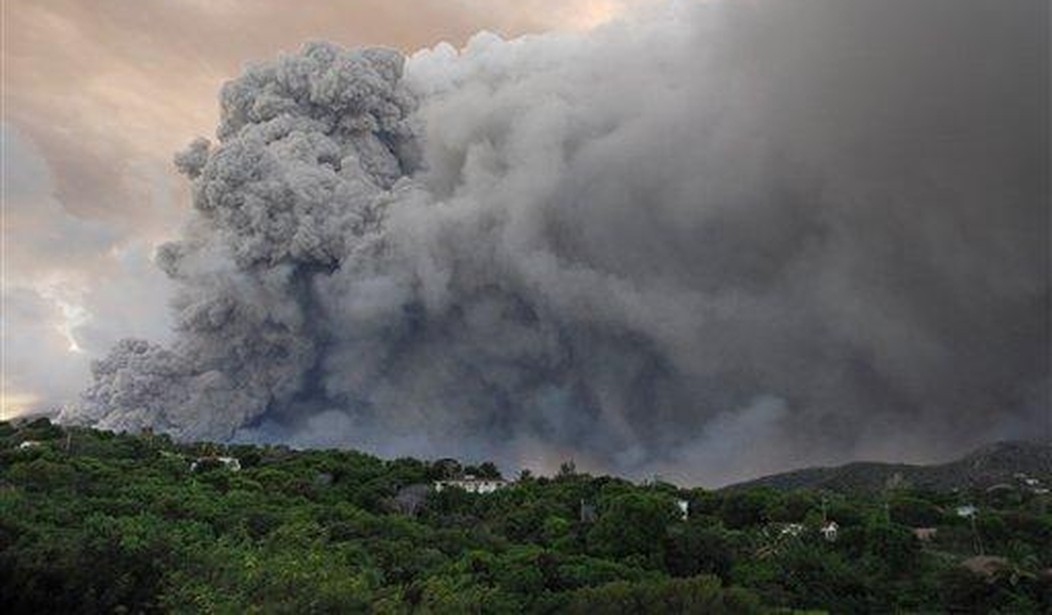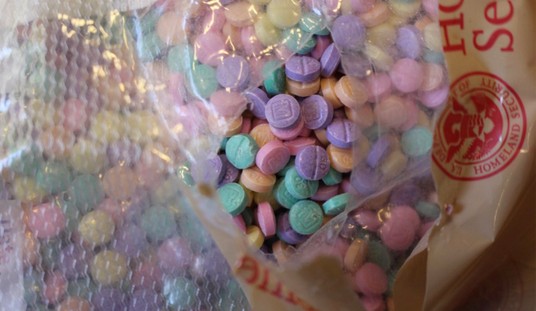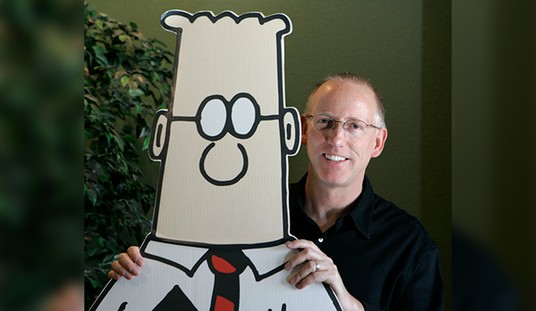In the 1980s, dozens and dozens of best-selling albums and MTV hits were recorded in a small recording studio owned by legendary Beatles producer George Martin located on a tiny island in the West Indies called Montserrat. For superstar musicians who could afford the studio’s high hourly fees, the island served as a tropical getaway, where they had the private run of the studio and could swim in the facility’s pool, windsurf, play golf, and drink and/or jam at the local pub on an island whose local population of about 11,000 largely didn’t give a damn about their superstar status in England and the States.
The 2021 documentary “Under the Volcano,” currently playing on the Paramount+ streaming platform, was directed by Australian filmmaker and actress Gracie Otto. As Mark Knopfler of Dire Straits says in a voiceover that accompanies some ravishing helicopter and beachfront clips at the start of the film, “Going to Montserrat was like going into a dream,” followed by a warning that “Reality is always different than what you think it will be.” The film documents the studio’s decade-long existence and features interviews with many of the musicians who recorded there, many who loved the island and the studio — and a few who didn’t. It begins, logically enough, with why Martin built the studio in the first place.
“My God. It looks like a hospital!”
To understand how the Montserrat studio came into existence, it’s necessary to go back to the days of Martin recording the Beatles in the 1960s in what is now called Abbey Road Studios in London, where the Beatles recorded the majority of their discography.
Nearly a century of awe-inspiring sounds in numerous genres, from rock to classical to comedy albums to film soundtracks, have emerged from Abbey Road, but to this day, its studios have an exceedingly clinical atmosphere. It was even worse prior to the 1970s. Winston Churchill, after recording a speech there during WWII, exclaimed, “My God. I think I’ve come to the wrong place. It looks like a hospital,” after staring at the many studio technicians toiling in their white lab coats.
According to longtime Beatles engineer Geoff Emerick in his autobiography, while the band was recording “The White Album,” John Lennon called EMI’s Abbey Road Studio Two a “sh*thole of a place.”
He gestured with his arms and I knew exactly what he meant. There was nothing nice about the EMI studios at Abbey Road in those days, especially for the Beatles, who were virtual prisoners of their own fame. They had no relaxation facilities at all; for them, it was more like working in a prison. Sure, there was a canteen downstairs, but they couldn’t go there for fear of being mobbed. Neither could they go out for a breath of fresh air, thanks to the ever-present legions of fans waiting outside. They didn’t even walk around the corridors or go into the other studios, except on the rare occasions when there was another artist working whom they knew well and were willing to socialize with.
So, for all intents and purposes, we were all locked in that studio each day, from the time we started until the time we finished. Sure, part of it was set up as a kind of sitting room, where they had their cups of tea and meals. But the recording area was the most awful working environment: harsh industrial lighting and bare brick walls adorned with huge mattresses stuffed with seaweed. And management was woefully oblivious to the conditions: when the Beatles had requested some better lighting around the time of the Pepper sessions, EMI gave us exactly three fluorescent tubes with colored gels wrapped around them, clumsily affixed to a microphone stand. Needless to say, they gave out almost no color whatsoever, but they remained, nonetheless, a mute symbol of the incompetence we had to put up with every day.
So when Martin left EMI and built AIR (short for Associated Independent Recording) Studios in London in 1970, he knew he also wanted to build another studio where superstar musicians could record in privacy in a warm tropical setting. Martin’s first thought was to buy a ship, but his studio designer quickly talked him out of it, as getting the ship’s engines and other mechanical sounds off the background of a recording track would be impossible.
Martin then explored Plan B: building a small recording studio permanently housed on a Caribbean island. He found the small island of Montserrat, fell in love with its tropical climate, lush verdant trees, and friendly population, purchased a residence there, and had his engineers and boffins heavily modify the structure and expand it to turn it into a recording studio, with a mixing desk custom designed by legendary electronics engineer Rupert Neve. There was a swimming pool, a dining area, and the studio’s control room window overlooked a nearby golf course.
“I’m from Chicago — we don’t do volcanos.”
Visually, “Under the Volcano” contrasts its early shots of Martin in the 1960s in suits and tuxedos, holding a cigarette and pensively smoking with an air of drama, with photos of a much happier man in Montserrat, dressed in shorts, denim shirts, and polo shirts, when his studio opened in 1979. There are even posed comedy shots of Martin falling into his island retreat’s swimming pool while holding a (wired, for you younger readers) telephone.
“Montserrat for George was something more than just a commercial operation,” Mark Knopfler tells his interviewer, adding, “He’d fallen in love with Montserrat, and he had something else in his mind just to be able to tie in creativity with being in a special place.” Elton John’s longtime percussionist Ray Cooper says, “George’s idea was to take people out of an environment to put them into harmony with nature. But also, have time together to talk, to have dialogue and what he knew would happen was that for a lot of bands who had never been in that situation, that would evoke new ways of thinking and therefore, new musical ideas.”
The island had a long-dormant volcano, which we will return to in due course. (Per the legendary writer’s rule, Chekov’s Volcano.) Earth, Wind & Fire bassist Verdine White delivers one of the film’s funniest lines early on in “Under the Volcano” when he says, “I’m from Chicago — we don’t do volcanos.” But that didn’t stop EWF from recording at AIR Montserrat in 1980.
White recounts, “I had heard that the ladies that were working in the field with their machetes, when they were bringing our equipment from the airport to the studio, you know [in] the big [flight] cases with Earth, Wind & Fire [printed] on them, they had their machetes and they dropped them and applauded because they knew we were coming. They just applauded the cases! We hadn’t even [gotten] there yet, and it was beautiful.”
Paul McCartney arrived in 1980, shortly after the death of John Lennon, to record in Montserrat. Having written “Ebony and Ivory,” he invited Stevie Wonder to sing the duet with him. He also invited Ringo Starr, Carl Perkins, and bassist Stanley Clarke. In between recording sessions, the musicians would head to the local bar, where there was an electric piano, to jam. One night, Wonder played there until 4:00 in the morning, improvising vocals about the joys of island life on Montserrat to the cheers of the bar’s patrons. Wonder left a $5,000 tip that night for the bar’s house band, much to their delight.
The Police, recording their “Ghost in the Machine” and “Synchronicity” albums in Montserrat, used the studio crew to sing backing vocals on “Invisible Sun,” and filmed the video for “Everything She Does is Magic” there. (Including, to George Martin’s horror, a scene where Andy Summers jumps up and dances on the studio’s famed, very expensive, and delicate Neve mixing console. However, Sting told Otto, “It didn’t go well with Mr. Martin. But Andy didn’t harm it — he’s very light.”)
Summers said that recording in Monserrat “was like the rock star dream. This was like the Beatles or something. You sort of reached the pinnacle with going to those studios.” While The Police loved the tropical atmosphere, the three band members fought very aggressively during those sessions, and all three became divorced from their wives while staying on the island. For the purposes of getting no audio bleed between the instruments when recording, their producer Hugh Padgham had the band record in three rooms, with Sting playing bass in the control room, Summers on guitar in the main studio, and Stewart Copeland playing drums outside in the dining patio.
While there’s no doubt that Synchronicity has glorious sonics, as Copeland points out in the documentary, “perfect separation” was also the perfect metaphor to describe how the band’s relations had spiraled downward, ultimately causing the band to implode after their world-beating tour to promote the album.
“I need to hear traffic!”
Mark Knopfler warned at the beginning of the film that “Reality is always different than what you think it will be.” Not all bands benefitted from the tropical atmosphere. “Under the Volcano” has a clip of the late Lou Reed, a dedicated Manhattanite, telling an interviewer, “We went to Montserrat once and recorded. That wasn’t a good experience for me. You know, palm trees, and the ocean, and sands to relax on. I need to hear traffic!”
Nick Rhodes of Duran Duran told Otto that he clashed with the tropical climate and ended up working alone at night to avoid having to put up with his bandmates constantly jumping into the swimming pool and partying, but said that Simon Le Bon loved the island lifestyle. Neil Dorfsman, the co-producer of Dire Straits’ “Brothers in Arms” album and its smash hit single “Money for Nothing,” says that recording in Montserrat “was almost too chill in a way:”
I remember we were doing some track a couple of weeks into the record, and I was looking out at [the band], and everybody was like in a towel with suncream on their nose, [wearing] sunglasses. They were playing like 40 beats per minute, and I was like, “we’re making a record here!” It was too mellow, you know!
Anytime in the studio, it’s very easy to lose perspective, especially when you’re locked up, and it becomes your whole world. In fact, George Martin, down in Montserrat said to me, “You know Neil, a producer can either drive the bus or he can sit next to the driver with the roadmap, and it was up to me to sort of keep that energy higher, because the record, I think, was suffering.
Dorfsman and Dire Straits ultimately finished “Brothers in Arms” at Manhattan’s Power Station recording studio. Like Lou Reed, they needed to hear traffic as well to record. But the legendary guitar riff and sound that Knopfler achieved on “Money for Nothing” was AIR Montserrat all the way — Dorfsman later admitted he couldn’t recreate that incredible guitar sound in New York.
Regarding “Money for Nothing,” after Knopfler wrote the “I want my MTV” opening for the song, he wistfully thought that it was too bad Sting wasn’t around to sing this, as he used the Police’s “Don’t Stand So Close to Me” melody, to which somebody replied, he is — he’s vacationing on the island to do some windsurfing.
Crossfire hurricanes and volcanos
The last group to record at AIR Monserrat was The Rolling Stones, who recorded their comeback album “Steel Wheels” there after Mick Jagger and Keith Richards had reconciled over their extremely public in-fighting in the mid-to-late ‘80s:
Yve Robinson, the studio’s managing director, told Otto that the Stones have a reputation for trashing whatever venue they’re staying at on their last day, and sadly, Montserrat was no exception. Shortly after the band left, Hurricane Hugo flattened the island, resulting in much of the population losing their homes and the studio becoming flooded. The structure survived the hurricane, but the interior was a major casualty, Kenneth Womack wrote in “Sound Pictures,” the second volume of his biography of George Martin:
George visited the site to survey the damage for himself. Standing inside AIR’s main studio, he opened a piano keyboard only to discover that the keys were covered in mold. In that moment, George knew that the studio’s electronics couldn’t possibly have survived. “I realized then we were done,” he later recalled.
Further devastation would occur six years later when the island’s long-dormant volcano awoke in spectacular fashion. The video footage that “Under the Volcano” collects is equal parts astonishing and terrifying, watching an enormous cloud of volcanic dust make the helicopter flying into it look the size of a housefly. Otto interviews Rose Willock, an island DJ who says that during the eruption, “I sat before the microphone and said, ‘Everybody, I know that you’re scared. If you feel like praying, pray. If you feel like crying, cry. But I’ll be here with you all the way, all the time. I’ll be here, just keep listening to the radio station. This is Rose. It’s going to be okay; just stay with me.’”
The ruins of AIR Montserrat are now located within the island’s Volcanic Exclusion Zone, which resembles nothing less than a modern-day Pompeii. After the eruption, much of Montserrat’s population evacuated to safer lands, and now only about 4,000 people remain on the island.
“Under the Volcano” is a paean to the intersection of the rise of MTV and the compact disc supercharging record label bank accounts in the 1980s and allowing bands with seemingly unlimited studio budgets to record in a staggeringly beautiful setting. In response to touring his wrecked studio in 1989, Martin said:
“After 10 great years of recording there the music business had changed,” he proclaimed. “The moguls running the business no longer wanted their artists miles away, outside their control. That coincided with the devastation caused by the hurricane and sadly the studios had to close.”
While recording budgets began to shrink at the beginning of the 1990s, by the end of the decade, the rise of Napster would ensure an even further decline. Thanks to a combination of sharp budget cutbacks and dramatically rising computer technology, today’s recording industry is a vastly different world. For an up-and-coming rock group, often the only recording session held in a proper studio is to capture the band playing with their drummer, and then everything but the drum tracks are replaced or overdubbed in small studios, or even home bedrooms and dens on laptops or PCs. The rise of such technology has made recording affordable to everyone, but very few musicians today will have produced music in a setting as glamorous as the one depicted in “Under the Volcano.”
As Ray Cooper said in the film, “Music is the liquid architecture of our emotions, and George was a wonderful architect. He had a way of putting things in the right place; in a place that was comfortable, in a place that grew. It was fruitful.”










Join the conversation as a VIP Member